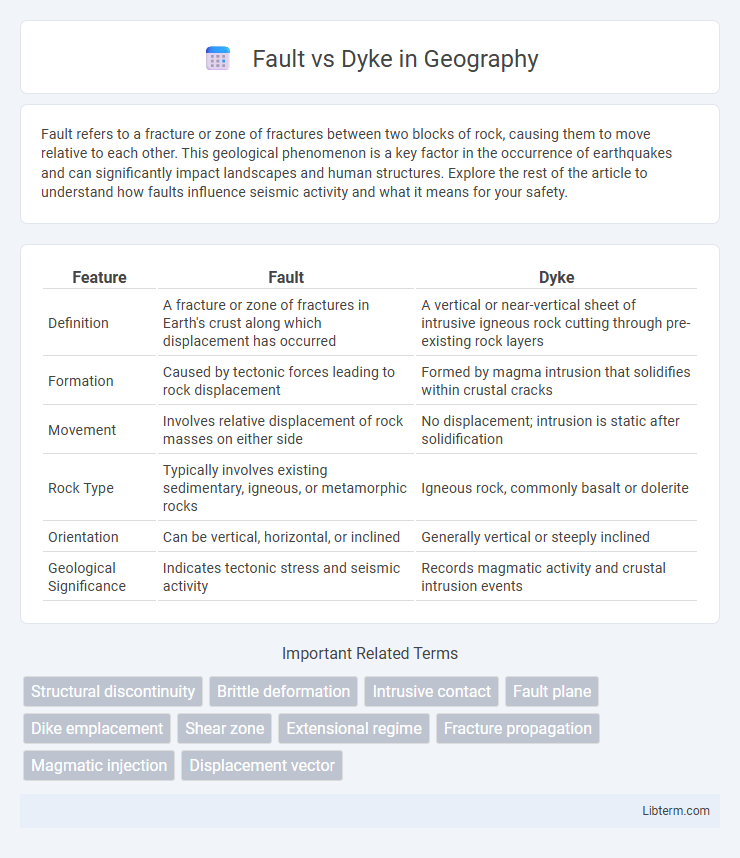Fault refers to a fracture or zone of fractures between two blocks of rock, causing them to move relative to each other. This geological phenomenon is a key factor in the occurrence of earthquakes and can significantly impact landscapes and human structures. Explore the rest of the article to understand how faults influence seismic activity and what it means for your safety.
Table of Comparison
| Feature | Fault | Dyke |
|---|---|---|
| Definition | A fracture or zone of fractures in Earth's crust along which displacement has occurred | A vertical or near-vertical sheet of intrusive igneous rock cutting through pre-existing rock layers |
| Formation | Caused by tectonic forces leading to rock displacement | Formed by magma intrusion that solidifies within crustal cracks |
| Movement | Involves relative displacement of rock masses on either side | No displacement; intrusion is static after solidification |
| Rock Type | Typically involves existing sedimentary, igneous, or metamorphic rocks | Igneous rock, commonly basalt or dolerite |
| Orientation | Can be vertical, horizontal, or inclined | Generally vertical or steeply inclined |
| Geological Significance | Indicates tectonic stress and seismic activity | Records magmatic activity and crustal intrusion events |
Understanding Geological Structures: Faults and Dykes
Faults represent fractures in Earth's crust where significant displacement has occurred due to tectonic forces, often resulting in earthquakes and crustal deformation. Dykes are vertical or steeply-inclined sheets of igneous rock that intrude into pre-existing rock formations, forming when magma solidifies in cracks. Understanding the structural differences between faults and dykes is essential for interpreting geological processes, assessing seismic risk, and exploring mineral and hydrocarbon resources.
Defining Faults: Characteristics and Formation
Faults are fractures in Earth's crust where blocks of rock have slipped past each other, characterized by the displacement of layers and significant seismic activity. Their formation results from tectonic forces causing stress beyond rock strength, leading to brittle failure and movement along the fault plane. Unlike dykes, faults represent zones of weakness and motion rather than intrusions of magma.
Defining Dykes: Characteristics and Formation
Dykes are planar, tabular igneous intrusions that cut across pre-existing rock layers, formed when magma forces its way through fractures in the crust and solidifies. Characterized by their vertical or steeply inclined orientation, dykes often vary in thickness and can extend for several kilometers, providing critical insight into volcanic plumbing systems. Unlike faults, which are fractures along which displacement occurs, dykes represent the emplacement of molten rock without significant displacement of the adjacent rock units.
Faults vs Dykes: Key Differences
Faults are fractures in rock where significant displacement has occurred due to tectonic forces, whereas dykes are vertical or steeply inclined sheets of igneous rock that cut through pre-existing formations. Faults primarily represent zones of weakness and movement, often associated with earthquakes, while dykes form as magma intrudes into cracks, solidifying as distinct bodies. The key differences lie in their formation processes, structural roles, and material characteristics--faults involve brittle deformation and rock displacement, whereas dykes involve igneous intrusion without displacement.
Types of Faults in the Earth's Crust
Faults in the Earth's crust are fractures where blocks of rock have slipped past each other, classified mainly into normal, reverse, and strike-slip faults based on the direction of movement. Normal faults occur due to extensional forces causing the crust to lengthen, while reverse faults result from compressional forces that shorten and thicken the crust. Strike-slip faults are characterized by lateral movement parallel to the fault plane, often associated with transform plate boundaries and significant seismic activity.
Types of Dykes and Their Geological Significance
Dykes are classified primarily into igneous and sedimentary types, with igneous dykes forming when magma intrudes into fractures and solidifies, cutting across preexisting rock layers. These structures serve as critical indicators of past tectonic stresses and magma pathways, thus helping geologists reconstruct volcanic activity and crustal deformation history. Understanding the orientation and composition of dykes provides insight into regional tectonics and the evolution of the Earth's lithosphere.
Causes of Fault Formation
Faults form primarily due to tectonic forces causing stress accumulation in the Earth's crust, leading to brittle failure and displacement along fracture planes. Differential stress, such as compressional, tensional, or shear forces, deforms rock layers, initiating faulting where strain exceeds rock strength. In contrast to dykes, which result from magma intrusion, fault formation is predominantly driven by mechanical stress rather than magmatic processes.
Causes of Dyke Formation
Dykes form when magma intrudes into cracks within the Earth's crust, solidifying as vertical or steeply inclined sheets due to tectonic stresses that create fractures. Unlike faults, which result from the brittle deformation and displacement of rock layers caused by tectonic forces, dykes are igneous intrusions filling these fractures. The primary causes of dyke formation include extensional tectonic regimes that generate fissures and magmatic activity forcing magma into these openings.
Geological Impacts of Faults and Dykes
Faults create fractures in the Earth's crust where displacement occurs, significantly influencing seismic activity and landscape formation by enabling earthquakes and shaping topography. Dykes are vertical or steeply inclined intrusions of magma that solidify within existing rock layers, altering the local geology by cutting across strata and often acting as conduits for mineralizing fluids. Both faults and dykes play crucial roles in structural geology, with faults controlling stress distribution and rock deformation, and dykes contributing to crustal growth and modification of rock permeability.
Real-World Examples: Famous Faults and Dykes
The San Andreas Fault in California is a prime example of a transform fault known for causing significant earthquakes, while the Great Dike in Zimbabwe represents a massive intrusive igneous feature formed by magma filling a crack in the Earth's crust. The East African Rift Valley showcases fault systems actively pulling apart the continent, contrasting with Iceland's dykes, such as those in Reykjanes Peninsula, which exemplify volcanic fissures created by magma injection. Famous faults and dykes illustrate tectonic dynamics that shape landscapes and drive seismic and volcanic activity worldwide.
Fault Infographic

 libterm.com
libterm.com